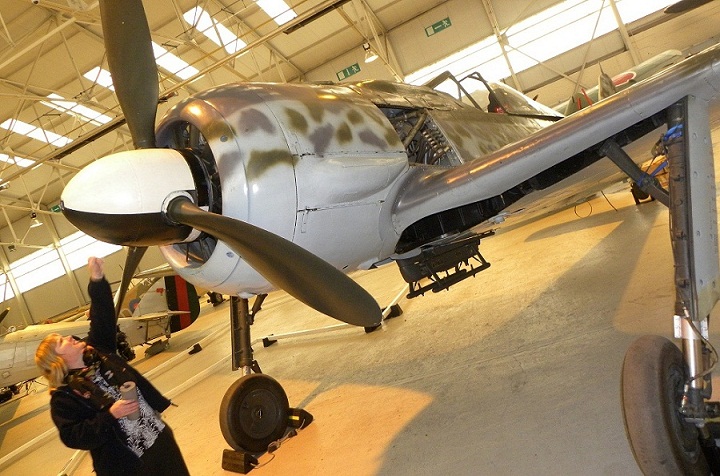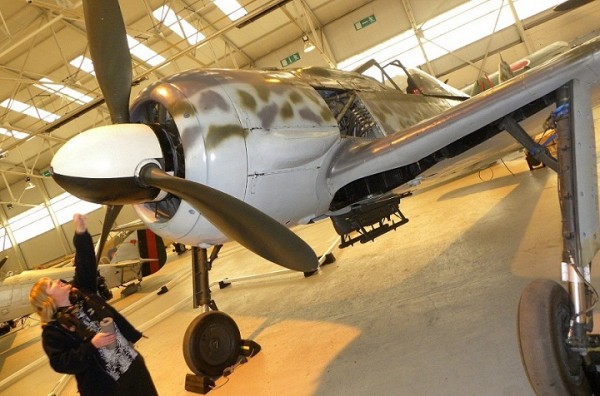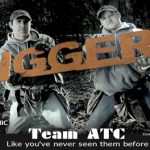Autumn is off to a flying start at the Royal Air Force Museum Cosford with the arrival of a Focke-Wulf Fw 190 A-8. These German fighter aircraft were widely used by the Luftwaffe during World War Two and an example of this is now on display to visitors within the Museum’s Warplanes collection.The Focke-Wulf Fw 190 was a single-seat single-engine multi-role fighter-bomber, capable of carrying a larger bomb load than its counterpart the Messerschmitt Bf109. Entering Luftwaffe service in August 1941, the Fw 190 proved superior in many respects to the Royal Air Force’s main frontline fighter, the Spitfire V. It took the introduction of the much improved Spitfire IX in July 1942 for the RAF to gain an aircraft of equal capability.
One of the more unusual roles for the Fw 190 was as part of the twin-aircraft drone combination, code-named mistletoe or Mistel. A single engine fighter was mounted on top of a twin engine bomber, and on lining up with the target the fighter detached itself, leaving the bomber, packed with explosives, to impact the target.Cosford’s Fw 190 is a unique survivor of a Mistel combination. Surrendered in Denmark in May 1945, the Fw 190 was part of a combination with a Junkers Ju 88, and assigned to a unit which trained Mistel crews. Flown to Germany as a twin combination, the Fw 190 was then split from its Ju 88 in order to be ferried to the UK for examination. The Ju 88 half never reached the UK, and it is assumed it was scrapped.
The Museum’s aircraft then spent several years on display at RAF Cranwell before a short period in storage at RAF Biggin Hill. In 1986 it went on loan to Imperial War Museum Duxford where it was given corrosion treatment and after colour scheme research, was given an authentic daylight fighter scheme. Four years later, the Fw 190 A-8 was moved to Imperial War Museum South Lambeth and placed on display, suspended in their refurbished Museum. Officially becoming property of the RAF Museum in 1998 after the title was transferred by the Ministry of Defence, the aircraft remained on display at Lambeth until December 2012 when it was moved to the RAF Museum Cosford in Shropshire.
After a period of time spent in the Museum’s award winning Sir Michael Beetham Conservation Centre and undergoing a small amount of maintenance work, the aircraft has now been placed on display for aviation fans to enjoy.
Clare Carr, RAF Museum Cosford Assistant Curator says:“After many years suspended in the Imperial War Museum London, we are delighted to be able to offer visitors to Cosford a closer view of this unique Luftwaffe airframe, which complements the other World War Two era aircraft displayed in our Warplanes hangar.”
Aircraft History – Focke-Wulf FW190A-8
1944-45 Manufacture date. The A-8 was a fighter-bomber version produced in greater numbers than any other sub-type.
8 May 45 One of the components of at least four Mistels surrendered at Tirstrup, Denmark – had formed part of a Ju88/FW190A `Mistel S3B’ trainer composite aircraft of former II/KG200, assigned on paper at least to IV/KG200, comprising the FW190 and a Ju88H-1.
30 Jul 45 Ferried from Tirstrup to Schleswig as a combination by a German pilot in formation with two other `Mistel’ combinations, AM76 and AM77 (both Ju88/FW190A) under RAF fighter escort.
At Schleswig the composite aircraft was separated into its components for ferrying to the UK, but the Ju88H was not delivered and is assumed scrapped at Schleswig. (Photo of the 3 Ju88 components at Schleswig Aug 45 – War Prizes p.92).
11 Nov 45 The FW190A was ferried from Amsterdam/Schipol to RAE Farnborough by Squadron Leader Easby – after the German aircraft exhibition of 29 Oct-9 Nov 1945 at Farnborough. The aircraft was not test flown whilst at the RAE.
30 Nov 45 To No.6 MU Brize Norton, Oxfordshire, selected as the storage unit for German aircraft received in the UK.
18 Sep 46 Allocated to RAF Cranwell, Lincs, for the RAF College Museum, established that month on Cranwell North Airfield which included several German Aircraft including the Me 262 now at Cosford, He162A 120235 also now at South Lambeth and Me163B W/Nr 191660 now at Duxford but originally at South Lambeth. Photo at Cranwell 1960 – Control Column Nov/Dec 77 p.180.
Mar/ Apr 61 Noted at No.71 MU Bicester, Oxfordshire, stored with other AHB aircraft, still faintly marked as AM75. (ABD April 1962 p.41)
15 Jul 61 At RAF Biggin Hill, Kent by this date, stored alongside other AHB aircraft. Photo: Captive Luftwaffe (009336) p.38. Remained stored at Biggin Hill for several years. Photo (Sep 65); Aero Modeller Jan 66 p.24; Control Column Dec.65; Flying Review International Sep 1967 p.878;
Wrecks and Relics – The Album (colour) p.37, 1964; Aeroplane Sept 2004 p.84; Air-Britain Aeromilitaria Winter 2004 p.185 (colour).
18 Oct 67 Allocated to Imperial War Museum on loan from the RAF.
Jun 68 On display at South Lambeth by this date – Photo: Control Column Jun 68 p.14. Displayed in mottled blue/grey colour scheme with no codes. Other photos at South Lambeth in this condition – Air Extra No.13 p.6; Captive Luftwaffe (009336) p.39; Deutsche Old Timer Flugzeug (024135) p.116.
Apr 86 Moved to IWM, Duxford, Cambs. Photos as first delivered to Duxford – Aviation News 19 Feb-3 Mar 88 p.916; Aircraft Illustrated Jan 87 p.50; Scale Models International Jul 86 p.315.
Feb-Apr 89 Repainted and restored at Duxford by the Aircraft Restoration Company (ARC) on behalf of the IWM. Given corrosion treatment and rectification of previous damage. Following colour scheme research carried out by the IWM with help from the Smithsonian Institution, the ARC applied an authentic daylight fighter scheme used by a minority of FW190 units. At the request of the IWM, no individual identifying markings were applied. See Aeroplane Monthly Nov 89, p.668 and December 2012 p.6. Photo: undergoing restoration -Warbirds Worldwide Directory (1989) p.111.
Jun 89 Returned to IWM South Lambeth by this date for suspended display in the refurbished Museum, reopened 29 Jun 1989. Photos suspended in gallery – Aeroplane Monthly Museums Guide Apr 94, p.10 and May 92, p.10; War Prizes – The Album p.106; Flypast September 2010 p.62. Underside still shows fittings for its Mistel role including locating sockets for the mounting struts and cutouts in the skin to allow the connecting services and fuel pipes to pass through. Photo – Mistel (Forsyth) p.270.
31 Aug 93 Allotted RAF Maintenance Serial 9211M.
3 Aug 98 Title transferred to RAF Museum by Ministry of Defence.
The Museum is open daily from 10am and admission is free of charge. For more information on the Museum, visit www.rafmuseum.org or call 01902 376200.

























